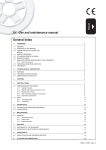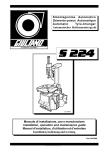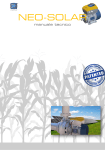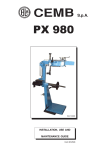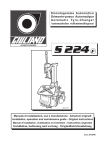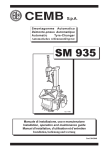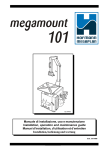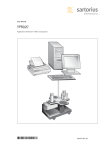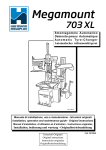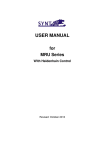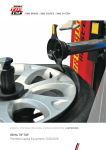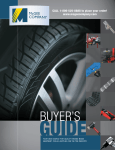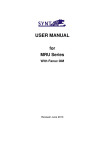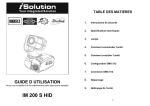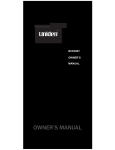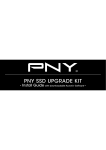Download Use and maintenance instruction manual
Transcript
Use and maintenance instruction manual Original Instructions Ed.02/15 Cod. 3038337 English SM 951 EC DECLARATION OF CONFORMITY CEMB S.p.a. - Via Risorgimento, 9 - 23826 Mandello del Lario (LC) - ITALY do hereby declare on our own responsibility that the product: Passenger Car Tyre Changer Data Plate which this statement refers to meets the following directive 86/217/CEE - 2006/42/CE 2006/95/CE - 2004/108/CE EN 12100 - EN 60204-1 as well as the following: The signature of this declaration of conformity is the person authorised to provide for the technical literature file. Mandello del Lario, 18/12/13 The model of the present declaration complies with directive EN ISO / IEC 17050-1 ROHS DECLARATION OF CONFORMITY CEMB S.p.a. - Via Risorgimento, 9 - 23826 Mandello del Lario (LC) - ITALY do hereby declare on our own responsibility that the product: Passenger Car Tyre Changer which this statement refers to meets the following directive:: 2011/65/EU (RoHS) Scrapping must be made in accordance with the following directive: 2002/96/CE e 2003/108/CE (RAEE) as well as with the national laws in force in the Country of Installation. Mandello del Lario, 24/06/14 Remarks: for all the machines/appliances distributed from 01.01.2006 on, also all non-original spare parts will have to meet the directive 2002/9/C E (RoHS). RAEE DECLARATION OF CONFORMITY CEMB S.p.a. - Via Risorgimento, 9 - 23826 Mandello del Lario (LC) - ITALY do hereby declare on our own responsibility that the product: Passenger Car Tyre Changer which this statement refers to meets the following directive: 2002/96/CE e 2003/108/CE (RAEE) Raccolta differenziata This equipment is subject to the regulations foreseen by Directives 2002/96/CE and 2003/108/CE (RAEE) and therefore it cannot be scrapped as a generic scrap material but through specific collection circuits; the symbol with “barred tank” marked on the product refers to this prescription. Scrapping must be made in accordance with Directives 2002/96/CE and 2003/108/ CE (RAEE) as well as with the local Regulations in force in the Country of installation, the non-respect of the Directive is subject to sanctions according to the national Laws of the Country of destination. Abandonment or wrong scrapping of the equipment subject to Directive 2002/96/CE can cause serious damage to the environment. The manufacturer is available, according to the Directive, to scrap the equipment; for this service, please contact the manufacturer or your dealer. Mandello del Lario, 24/06/14 2 CONTENTS CHAPTER Page 1.0 INTRODUCTION......................................................................................................................................................4 1.1_Tyre-Changer data...............................................................................................................4 1.2_ Manufacturer data.............................................................................................................................4 1.3_Data plate.............................................................................................................................4 2.0 GENERAL DESCRIPTION.........................................................................................................................4 3.0 SPECIFICATIONS.....................................................................................................................................5 4.0 WARNING DECAL PLACEMENT...........................................................................................................6 5.0 GENERAL SAFETY RULES........................................................................................................................7 6.0 SAFETY DEVICES................................................................................................................................7 7.0 Tra NSPORT...................................................................................................................................................................8 8.0 UNPACKING.....................................................................................................................................................8 8.1_Mounting the tilting tower.............................................................................................................9 9.0 Installa TION...................................................................................................................................................11 9.1_Space required to position..........................................................................................11 9.2_Tyre-Changer placement and connections................................................................................11 10.0 EQUIPMENT COMPONENTS...............................................................................................................12 11.0 DESCRIPTION OF THE CONTROLS AND OPERATING TEST..........................................................................13 12.0 RIM AND TYRE IDENTIFICATION.....................................................................................................14 13.0 VALVE POSITION......................................................................................................................................14 14.0 WHEELS AND TYRES CLASSIFICATION......................................................................................................15 14.1_ Standard wheels.................................................................................................................................15 14.2_Low-profiled tyre (UHP) wheels.............................................................................................15 14.3_RUN-FLAT tyre wheels.....................................................................................................15 15.0 OPERATION...........................................................................................................................................16 16.0 BEAD BREAKING..............................................................................................................................................16 16.1_Bead breaker shovel adjusting operations ..............................................................................16 16.2_Bead breaking..........................................................................................................17 17.0 ADJUSTING THE TURNTABLE LOCKING MEASUREMENTS...............................................................18 17.1_Additional adjustments of the turntable locking measurements...........................................19 18.0 WHEEL locking on the TURNTABLE......................................................................................................19 19.0 TYRE DEMOUNTING........................................................................................................................20 20.0 TYRE MOUNTING.........................................................................................................................21 20.1_ Lower bead mounting......................................................................................................................21 20.2_Upper bead mounting................................................................................................................21 21.0 INFLATION.............................................................................................................................................23 22.0 STANDARD ACCESSORIES...............................................................................................................24 23.0 OPTIONAL ACCESSORIES..............................................................................................................25 24.0 RE-POSITIONING.........................................................................................................................................26 25.0 STORAGE......................................................................................................................................26 26.0 SCRAPPING...............................................................................................................................26 27.0 OIL TREATMENT................................................................................................................................................26 28.0 MAINTENANCE...............................................................................................................................................27 28.1_ Standard maintenance.............................................................................................................................27 28.2_ Extraordinary maintenance..................................................................................................................27 29.0 TROUBLESHOOTING CHART..........................................................................................................28 30.0 WIRING DIAGRAM......................................................................................................................................30 31.0 PNEUMATIC DIAGRAM............................................................................................................................33 32.0 SERVICE REPORTS..............................................................................................................................34 3 1.0 INTRODUCTION Thank you for purchasing one of our Professional Tyre-Changer designed for demounting and mounting operations on standard, UHP and “run-flat” tyres. All you need to do to ensure the unit a correct function, efficiency and a long service life is to follow the instructions given by this guide that shall be carefully read and fully understood in every single part. 1.1 Tyre-Changer data: Please refer to “Tyre-Changer Model” and “Serial Number” data on the Data-Plate (see sample below) to provide our Technical Service Dept. with the necessary details for prompt assistance and spare-parts tracking. In case of discrepancies between Tyre-Changer data on Data-Plate and this Manual, please refer to Tyre-Changer dataplate only. 1.2 Manufacturer data: Please check the “Declarations of Conformity” at page 2 of this Manual and Tyre-Changer Data-Plate. 1.3 Data-plate: LOGO Model 2.0 GENERAL DESCRIPTION The tyre changer is designed to demount and mount tyres of cars and light commercial vehicles with rims of 10” to 28” and maximum diameter of 1100 (43”) mm. The tyre changer is designed to demount and mount conventional tyres of passenger cars, light industrial vehicles, next generation “self-supporting” RUN-FLAT tyres and low profile tyres (UHP) on steel and/or alloy rims, even big-size tyres. The Tyre-Changer is NOT intended for demounting completely- or partially-inflated tyres, dirty tyres, nor for rim bending or industrial wheels with split ring rims demounting. All these operations are forbidden. This manual is an integral part of the product. Before using the tyre changer, read carefully the warnings and instructions contained in this manual since they provide important information on operating safety and maintenance. Keep this Manual in good conditions for further references. Note: It is possible that some parts or components of standard production are different from the illustrations contained in this manual. 4 3.0 SPECIFICATIONS Connections: -Power supply: 400V - 3Ph - 50 Hz standard version 400V - 3Ph - 60 Hz 220V - 1Ph - 50 Hz 220V - 1Ph - 60 Hz 220V - 1Ph - 50/60 Hz 2 speed Inverter The effective data can be checked on the data-plate placed on the machine. -Operating pressure:8÷10 bar (116÷145 psi) -Air inlet pressure regulator set at 10 bar (145 psi) included -Inflating pressure limiter set at 3,5 bar (50 psi) included Working capacity: -Rim clamping from outside: from 10” to 26” -Rim clamping from inside: from 12” to 28” -Maximum rim width: 16” (415 mm) -Maximum wheel diameter: 43” (1100 mm) 400V 3Ph Turntable data: -Motor power: 0,8/1.1 Kw -Maximum torque: 1200 Nm -Clockwise rotation speed: 7÷14 rpm -Working noise level: < 70 dB Bead breaker data: -Bead breaker cylinder force at 10 bar: 30800 N (3140 kg) Layout data: -Net weight of the machine without optional accessories: 270 kg -Operating temperature range: min +5° C max +50° C (+41°÷+122° F) Standard accessories (ref. page 21): -Lubricating paste for mounting/demounting operations -Brush -Bead lifting lever -Jaw protectors for alloy rims -Kit of protectors for mounting tool -Protectors for bead breaker blade -Lubricator -filter- pressure regulator Overall dimensions (mm) Main optional accessories (ref. page 22): Packing details 2040 -Pneumatic bead pressing tool -Leverless device -Tubeless inflating system -Quick release device for mounting tool Gross weight 295 Kg. 113 0 (without optional accessories) 18 9 0 1080 Carton fig. A 1120 Wooden pallet 5 117 0 fig. B 4.0 WARNING DECAL PLACEMENT Cod. 3035727 Cod. 3005416 Cod.3005411 Cod. 3001104 Cod. 3025916 Cod. 3005742 Cod. 3005415 Cod. 3005413 Cod. 3005414 Cod. 3005410 Cod. 3037331 Cod. 3000048 Cod. 3037622 Cod. 3037621 Cod. 3016802 Cod. 3005414 WARNING: Replace any warning label immediately in case of damage or loss. Do not operate the Tyre Changer in case of warning labels lack. Do not hide any warning label by any mean. Do not interpose objects that obstruct or reduce the visual capacity of the operator. Refer to the above mentioned codes for warning labels ordering. 6 5.0 GENERAL SAFETY RULES The Tyre-Changer must be used by qualified and authorised personnel only. A qualified operator is someone who has fully understood the instructions described in this operation and maintenance manual supplied by the manufacturer, has been specifically trained and is aware of safety standards at his work place. Those in charge of using the machine shall not be under the influence of drugs, alcohol or other substances, which could compromise their physical and mental work capabilities. For greater security against on-the-job injuries, the operators shall wear safety footwear, gloves, protection goggles and shall NOT wear any form of loose clothing that could get caught up or restrict the operator’s movements. The operator must be able to: - read and ensure full comprehension of the use and maintenance manual to be able to use the machine correctly and safely. - read and understand the danger warnings. - understand the characteristics of the machine. - keep unauthorized people away from the working area. - make sure that the setting in motion of the machine has been carried out in compliance with all applicable rules and regulations. - make sure all operators are familiar with the machine and know how to use it safely and correctly. - avoid touching moving parts or pressurised parts without first disconnecting the machine from the electrical and air power supply. - keep the operation instruction manual with care in an easily accessible place, so that it can be consulted whenever needed. The Tyre-Changer must be used exclusively by experts who are specifically trained and by authorized personnel only. - The use of the machine is forbidden to disabled operators if their disabilities may affect the safety of the working operations. -Any tampering or modification to the equipment without the manufacturer’s express prior authorization relieve the manufacturer from all forms of liability in the event of damages deriving from or referable to such actions. -Removal or tampering with the safety devices provides grounds to immediately cancel the warranty and involves a violation of European Safety Legislation. -The Tyre-Changer is equipped with informative and warning decals, which are designed and produced to last in time. If they should deteriorate, user may request replacement decals. IN CASE OF FIRE, USE ONLY DRY CHEMICHAL OR CO2 EXTINGUISHERS TO PUT THE FIRE OUT. CO2 WATER extinguisher FOAM extinguisher POWDER extinguisher DRY materials FLAMMABLE liquids OK NO ELECTRICAL equipment NO OK OK OK OK OK OK NO OK OK extinguisher 6.0 SAFETY DEVICES The tire changer is equipped with safety devices that are designed to guarantee the safety of the machine operator: - Pneumatic safety valve, installed inside the machine that prevents the pressure from exceeding 3,5 bar (50 psi) during inflation. - Pressure regulator and gauge that limits the maximum pressure of the circuit to 10 bar (145 psi). On Tyre-Changers equipped with “Tubeless inflating device”: -Limit Valve, installed onto the air tank that prevents the pressure from exceeding 11 bar (160 psi). Removing or tampering with safety devices immediately invalidates the guarantee represents a breach of the European Safety Legislation. 7 7.0 TRANSPORT - The Tyre-Changer must be transported in its original packaging and kept in the position indicated on the actual packaging. -The packaged machine has to be moved by mean of a fork lift of suitable capacity. Please, insert the forks as shown by the following picture “fig. 1”. 8.0 UNPACKING Remove the protective cardboard, remove all fixing screw and free the Tyre-Changer from its original pallet. Check the perfect condition of the machine, making sure that no part is damaged or missing, referring to the picture at page 10. If in doubt, please do not use the machine and get in touch with your Distributor for further steps. Keep packing elements away from children. All packing elements must be stored in the proper stocking areas. Note: All the most delicate surfaces of the Tyre-Changer are coated by a special rust-proof oil. Some oil traces may leak after coating procedure: please, remove them accordingly. Gross weigth 295 Kg. fig. 1 Use lifting equipment of suitable load-bearing capacity that is able to take the weight of the tyre changer (at least 500 Kg.); to lift the machine, use a transport strap with minimum load-bearing capacity of at least 500 kg. After tyre-Changer positioning, take of the lifting belt. 8 8.1 Mounting the tilting tower After unpacking the machine, mount the tilting vertical tower by following the instructions here below. Lift the tilting vertical tower using a band of adequate capacity. Insert the band as shown in the picture. . Lift the vertical tower as shown in the picture. Slightly loosen the screw of the tie rod by means of a 17mm spanner to easily position the vertical tower into its seat. Insert the vertical tower in its housing. Connect the bushings to the pin, then, insert it into the hole in order to lock the vertical tower. Connect the other bushings, as in the picture. 9 After having inserted the pin completely, tighten the screw properly. Tighten the screw of the tie rod, previously loosened to easily position the vertical tower into its seat. Pull the tilting system cylinder rod manually so that the hole coincides with the holes in the vertical tower. Insert the screw and tighten the nut but leave a little slack. Fit the protection of the tilting vertical tower and tighten the screw being careful not to break it. Insert the black pneumatic pipe into of pneumatic cylinder fitting. Insert the red pneumatic pipe into the fitting placed on the rear of the machine to complete the assembly operation of the vertical tower. 10 9.0 INSTALLATION 9.1 Space required to position 500 mm When choosing the place of installation, be sure that it complies with the current safety-at-work regulations. The Tyre-Changer must be connected to the main electric power supply and the compressed air system. It is therefore advisable to install the machine near these power sources. The installation area must leave at least the room shown in picture “fig. 1”, to allow all parts of the machine to operate correctly and without any restriction. 500 mm 500 mm Fig. 1 9.2 Tyre-Changer placement and connections Place Tyre-Changer onto a levelled-out, smooth and not slippery floor with a suitable load capacity. The machine must not necessarily be anchored to the ground, but if you prefer to do so, drill 4 (100 mm) deep holes on the ground just at the 4 holes of the machine base by using a 10 mm drill bit for concrete and of suitable length. Insert suitable metal anchor dowels in the holes drilled and secure firmly. If the machine is installed outside it must be protected by a appropriate lean-to shed. The electric network of the installation area must be provided with adequate earth plate and connected to an appropriate automatic circuit-breaker set at 16 A. NOTE: If the machine is supplied without the electrical plug, the user shall fit one -at least 16A- that is suitable for the voltage of the machine and complies with current regulations. Before connecting the machine, please check that the characteristics of your networks correspond to those indicated by machine’s data-label. Even small jobs done on the electrical system must be carried out by professionally qualified personnel. The Manufacturer is not responsible for damages caused by electrical connection different from the original indications. Unplug the unit from electrical and pneumatic outlets before moving and servicing. The pneumatic network of the installation area must be provided with an air outlet for the constant supply of 8 bars of minimum working pressure. - Connect the machine to the pneumatic network by means of the air fitting on the lubricatorfilter- pressure regulator unit- installed onto the right side of the machine. fig. 2 11 10.0 EQUIPMENT COMPONENTS Inflating device with pressure gauge Tilting tower Operating arm control Mounting/demounting tool Lubricator-filter- pressure regulator Jaw Turntable with adjustable jaws (patented) Bead breaker arm with adjustable bead breaker shovel angle (patented) and P.O. System (patented) Inflating device pedal Bead lifting lever Pedal control units Wheel support Mounting/demounting tool Finger tool “Shoe” shaped part 12 fig. 2 11.0 DESCRIPTION OF THE CONTROLS AND OPERATING TEST 5 6 7 9 8 1 2 3 4 1- Tilting tower pedal 2- Jaws control pedal 3- Turntable control pedal 4- Bead breaker control pedal 5- Operating arm control button (up/down) 6- Deflate button 7- Turntable adjustment knob 8- Inflation pedal control 9- Bead breaker shovel adjustment selectors Any test must be operated with no tyre onto the machine. Mind any component which could interfere with machine testing operations. 13 12.0 RIM AND TYRE IDENTIFICATION Before starting demounting a tyre, it is of CRUCIAL IMPORTANCE to identify the measurements of the rim and of the tyre, as well as to make sure that neither the rim nor the tyre are damaged. Warning: these very important procedures have to be correctly performed to reduce risks of tyre bursting while re-mounting and inflating the tyre on the rim. Each rim bears an indication of their diameter, width, number of humps etc. Example: 8Jx15H2 A= 8 Nominal width of the rim in inches (1 inch= 25.4 mm) B = J Size of the flange B C = 15 Nominal diameter of the rim in inches C A D = H2 Double hump (anti bead removing edge) D 8J x 15H2 Each tyre bears a considerable amount of details, among which are the dimensions, type and maximum speed. fig. 1 Example: 205/65 R 15 91H TL A B C D EF G A = 205Width of the tyre (the distance between tyre sides, expressed in millimetres). B = 65 Ratio percentage between the height of the section and its width. C = R Type of tyre (R= radial). D = 15 Indicates the keying diameter in inches (diameter of wheel), which must be the same as the rim. E = 91 Index of the maximum load born by each wheel. F = H Maximum admitted speed of the tyre (H= 210 Km/h) G = TL Type of tyre (TL= Tubeless) fig. 2 13.0 VALVE POSITION The picture on the right side symbolizes a rim as a clock face. The valve positions described by the following working steps always refer to the represented clock-face hours-marks. Warning: To avoid damaging the valve and the pressure sensor, if the latter is installed, you must always arrange the valve in the position indicated, following the instructions during bead breaking, mounting and demounting operations. fig. 3 Warning: It is strictly forbidden to mount tyres on rims with mismatching parameters (diameter and width). It is also forbidden to mount tyres with dimensions which are different from the ones stated in the car logbook. 14 14.0 WHEELS AND TYRES CLASSIFICATION 14.1 Standard wheels A “standard wheel” is a car wheel with steel or alloy rim, with center hole, drop centre close to the external border of the rim and a standard tyre (not RUN-FLAT nor LowProfile). 14.2 Low-profiled tyres (UHP) wheels Low profile tyres (UHP) are those in which the height (H) and the width (C) have a ratio lower than 0.5 (i.e. low profile series 45 stands for a ratio of H/C = 0.45). For tyres to be considered as low profile (UHP), they must also have a maximum speed code of equal to and/or higher than V. Maximum speed codes: Q= up to 160 km/h R= up to 170 km/h S= up to 180 km/h T= up to 190 km/h U= up to 200 km/h H= up to 210 km/h V= up to 240 km/h W= up to 270 km/h ZR= > 240 km/h ZR(Y)= > 300 km/h 14.3 RUN-FLAT tyres wheels RUN-FLAT tyres are those which allow to continue to drive the vehicle for a preset number of miles and at a preset speed, even if they have no internal pressure. These parameters change from one manufacturer to another. The market currently offers 2 different types of RUN-FLAT tyres: - Those with reinforced sidewall (self-supporting) where, thanks to a different mix and a reinforced structure, the shoulder of the tyre can bear the weight of the vehicle even when the internal pressure of the tyre is zero. - Those with internal support which have a ring inside the rim that bears the sidewall of the tyre when there is no pressure inside it. The internal support may be made of plastic (Pax-System) or of metal (Support-Ring). All the tyres which do not correspond to the above mentioned descriptions have to be considered as “standard tyres”. This Tyre-Changer is able to handle all types of wheels with “standard” tyres, LowProfile (UHP) and RUN-FLAT tyres with reinforced side. RUN-FLAT tyres with internal support (PAX System or Support-Ring type) mounting/demounting procedures need special accessories to be used according to precise dedicated instructions. The mounting and demounting procedure is similar with “standard” tyre, LowProfile tyre (UHP) tyre or RUN-FLAT tyre with reinforced side (self-supporting). Warning: It is compulsory to follow the demounting/mounting instructions carefully, in order to avoid tyre damages and the consequent risks for the vehicle and the passengers safety. 15 15.0 OPERATION Before carrying out any operation, deflate the tyre and take off all the wheel balancing weights. The operation of the tyre changer is divided into three parts: A) BREAKING THE BEAD B) REMOVING THE TYRE C) MOUNTING THE TYRE Note for use: The motorcycle rims are more and more frequently constructed by using special alloys or materials like carbon or magnesium. To lock this kind of rims it is necessary to use the motorcycle wheels adaptors kit and to limit the pressure exerted by turntable to 7 bar max., in order to avoid any irreparable damage of deformation. 16.0 BEAD BREAKING - Before starting each operation, make sure that there is no pressure sensor; if this is the case, it is advisable to check the status of its efficiency using an appropriate tool. 16.1 Bead breaker shovel adjusting operations (patented system) Depending on the type of tyre to be demounted, it is possible to lock the swing (selector 1) or adjust the angle of penetration of the shovel blade (selector 2) as well as the stroke of the bead breaker arm (selector 3). The selector 1 in ON position allows the shovel blade to swing, while the selector 1 in OFF position lock the shovel blade to the bead breaker arm. It is advisable to use the swinging shovel blade for breaking conventional tires with soft side. 3 1 2 For bead breaking a run flat tire, turn the selector 2 to 21° while keeping the selector 1 to OFF. For bead breaking a conventional tire, turn the selector 2 to 27° with the selector 1 to ON. For wheels having a pressure sensor, it is advisable to limit the stroke by means of the regulator 3. During bead breaking operations, pay particular attention to the position of pressure sensor (if any), usually inserted into the valve of the rim. Wrong movements of the bead breaker blade could damage the sensor. 16 16.2 Bead breaking - Using a suitable tool, remove all the counterweights from the rim, being extra careful not to damage the rim itself. - Check that the tyre is deflated. If not, deflate it. - Close the clamps (13) of turntable (14) completely by pressing the pedal (2). Position the turntable in a way that one of it’s flat sides is parallel to the rubber support surface (6) of the bead-breaker. 13 14 1 2 3 4 6 7 fig. 1 Bead breaking must be done with the utmost care and attention. When the bead breaker pedal is operated the bead breaker arm moves quickly and powerfully. Anything within its range of action can be in danger of being crushed. Bead breaking with the jaws in open position can be extremly dangerous for operator’s hands. Make sure that the jaws are closed and NEVER keep your hands on the sides of the tyre. - Position the wheel against the rubber wheel support (6) on the right side of the tyre changer (fig. 2) - Position the bead breaker blade (7) against the tyre bead at a minimum distance from the edge of the rim. Use bead breaker shovel protector for alloy rims. Pay attention to the blade, which must operate correctly onto the tyre and not onto the rim. (fig. 2) - Press down the pedal (4) to activate the bead breaker and release it when the blade has reached the end of its travel or in any case when the bead is broken. - The PO SYSTEM (patented device) starts automatically after releasing the pedal (4), granting no bead breaker shovel stuck between the edge of the rim and the bead of the tyre, pushing it toward the outwards. This avoids difficult manual operations and speeds up the work of the operator. 7 fig. 2 - Spin the wheel lightly and repeat the procedure on the whole circumference of the rim and on both sides, until the complete detachment of the bead from the rim. - It is recommended to lubricate the tire during the bead braking, thus preventing the bead from seating back to the rim and making the demounting operation easier. If there is a sensor, make sure it does not come into contact with the lubricant. CAUTION: While loosening the bead, just press on the bead and never on the side of the tire. 17 17.0 ADJUSTING THE TURNTABLE LOCKING MEASUREMENTS Before locking the wheel check the adjustment of the turntable and the dimensions of the wheel to lock. The tyre changer’s turntable is adjusted by the manufacturer at an intermediate measurement that goes from 10” to 20” ext (in relation to the outside of the rim) and from 12” to 22” int. (if the wheel is locked from the inside). The adjustment can be done by turning the two knobs located under the plate, between the two pneumatic cylinders (fig. 1-2). To increase the locking diameter, turn the knob clockwise (+) and, observing the decal (fig. 4), match the pin of cylinders P with the number of inches to increase. For example, if we turn the knob until the reference pin matches 1 we have a 1” increase, and so on. Each knob can be used separately. If the variation is done on both sides, the references are summed together (e.g. 2” + 1”=3” increase), starting from a 20” base, we can reach a maximum of 24”(rim clamping from outside) or 26” (rim clamping from inside). fig. 1 P fig. 3 fig. 2 fig. 4 fig. 5 fig. 5 18 17.1 Additional adjustments of the turntable locking measurements The values changed previously can be increased further still by moving the position of the 4 jaws as shown in the following figure(fig. 1). The increase of the clamping diameter ranges from 0” to a maximum of + 2” that shall be added to the increase obtained after the adjustment described in the previous paragraph. It is possible to reach a maximum of 26 “(rim clamping from outside) or 28” (rim clamping from inside). To change the position: Undo the screw (1) with an 8mm Allen wrench. Move the locking jaw (2) and the slide (3), repositioning them into the hole of the slide just at the guide hole (4) depending on the locking requested dimensions. Refer to the measurements given below. Reposition the jaw and lock with the screw (1) ensuring that the tightening torque is 72 Nm. ATTENTION: it is important that the above steps are performed identically on all 4 tightening jaws to prevent any unbalance when locking. 1 2 3 0” 4 fig. 1 + 1” + 2” 18.0 WHEEL locking on the TURNTABLE Before wheel locking, release the working space by tilting back the vertical arm and pressing the pedal (1). During arm tilting make sure that nobody stays behind the tyre-changer. OUTER LOCKING WHEEL • Position the jaws (13) on the turntable (14) by pressing pedal (2) down to its intermediate position. • Place the tyre on the jaws and, keeping the rim pressed down, press the pedal (2) as far as it will go to tighten the clamping jaws and lock the rim on the turntable. INNER LOCKING WHEEL • Position the jaws (13) so that they are completely closed. • Place the tyre on the jaws and press down the pedal (2) to open the jaws and thereby lock the rim. 19 During rim locking NEVER keep your hands under the tyre. For a correct locking operation set the tyre exactly in the middle of turntable. Make sure that the rim is firmly fixed by the jaws. Never keep your hands onto the wheel: the operating arm recovery to “working position” could set the operator at risk of hand crushing between rim and mounting tool. 19.0 TYRE DEMOUNTING • Set the locking button (11) in position 2. Move th operating arm (fig. 1) until the mounting tool (12) rests on the rim upper edge. Then lock everything by setting the locking button in position 1 (fig. 2). In this way, the arm gets locked both in a vertical and in a horizontal direction, while the mounting tool (12) is moved automatically of about 2 mm. from the rim. Fig. 2 11 11 Pos. 1 11 Pos. 2 Pos. 3 Fig. 1 Keep hands and other parts of the body as far as possible from the mounting tool when the turntable is turning. • With the lever (5) inserted between the bead and the front section of the mounting tool (12), move the tyre bead over the mounting tool. (Fig. 3) Note: In order to avoid damaging the inner tube, if there is one, it is advisable to carry out this operation with the valve at 2 o’clock position. Chains, bracelets, loose clothing or foreign objects in the vicinity of moving parts can represent a danger for the operator. • With the lever held in this position, let the turntable (14) (fig.1 page 17) rotate in a clockwise direction by pressing pedal (3) down until the upper tyre bead has completely come off of the wheel rim. • During the rotation while demounting the tyre, it is necessary to push down on the tire sidewall at the opposite side of the mounting tool in order thus reducing the stress on the bead and let it come off of the wheel rim. • In order to remove the inner tube, if there is one, without unlocking the operating arm, tilt back the tower by pushing pedal (1) down. • Repeat the operation for the lower bead until the tyre has completely come off of the wheel rim. 12 5 Fig. 3 20 20.0 TYRE MOUNTING -Check the rim and the tyre carefully, as per instructions at page 14 of this manual. -If the rim has been removed, lock it again onto the turntable, as described in the paragraph 19.0. -Carefully lubricate the whole inner surface of the rim and the beads of the tyre, both externally and internally right around the circumference, for a width of at least 3 cm. Fig. 1 Avoid contacts between the lubricating paste and the valve sensor, if any. 20.1 Lower bead mounting (see references at pag. 17, fig. 1) Fig. 2 - Put the tyre onto the rim, tilting the tyre at “12 o’clock” position in order to make both upper and lower beads go under the upper rim edge. - Press pedal ref. 1 to approach the mounting arm and position the mounting tool onto rim edge. - Incline the tyre to the bottom at “3 o’clock” position, driving the lower bead to the mounting tool in order to put the lower bead over the “shoe” shaped part and under the finger tool. Make sure the bead of the tyre rests on the “shoe” shaped part of the tool and under the finger tool in the opposite part. -Press the pedal ref. 3 to rotate the wheel clockwise, contemporarily press the tyre manually from “5 o’clock” position until the lower bead reaches the drop centre level. Keep the tyre pressed while rotating up to “8 o’clock” position to complete the lower bead mounting. 20.2 Upper bead mounting (see references at pag. 12) -Keep the mounting arm and the mounting tool at working position and proceed to mounting the upper bead, then put the tyre bead on the rim slightly tilted down to “3 o’clock” position. OK NO Bead correctly positioned over the “shoe” shaped part of the tool and under the finger tool. Bead incorrectly positioned and damaged between the “shoe” shaped part of the tool and the rim edge. 21 Make sure the bead of the tyre rests on the “shoe” shaped part of the tool and under the finger tool in the opposite part (fig. 3) -Press the pedal ref. 3 to rotate the wheel clockwise, contemporarily press the tyre manually from “5 o’clock” position to force the upper bead at drop-centre position. Keep it pressed while rotating up to “8 o’clock” position to complete the upper bead mounting.(fig. 4). Fig. 3 Fig. 4 ATTENTION: Make sure that rim and tyre always spin together. NOTE: Demounting and mounting are always done with the clockwise turntable rotation. Anticlockwise rotation is used only to correct operator’s mistakes. 22 21.0 INFLATION Tyres must be inflated with the utmost caution. The instructions below have to be read and followed strictly. This Tyre-Changer is not projected to protect operators and objects from accidental tyres explosions. ATTENTION: If tyre bead fails to fit in place at 3.3 bar pressure, it is necessary to repeat the bead loosening and lubricating procedures before trying again to inflate the tyre. If tyre had to burst or rim had to break under pressure, operators could be seriously injured or even killed. Make sure the rim and tyre are the same size. Also check the conditions of the tyre and rim to make sure there are no defects before starting to inflate. Inflate the tyre with short blasts of air and check the pressure frequently while inflating. This Tyre-Changer is automatically limited to an inflation pressure of 3,5 bar (50 psi). The pressure regulator is NOT a safety device preventing explosions risks and damages. NEVER EXCEED THE PRESSURE RECOMMENDED BY THE TYRE MANUFACTURER. Keep hands and body as far away as possible from the tyre during inflation. Pressure gauge Inflating pedal Deflate button Fig. 18 Fig. 19 Fig. 20 • Connect the inflation hose to the valve of the tyre. (fig. 19) • Make sure the rim and the tyre have the same diameter. • Make sure the rim and tyre are sufficiently lubricated; lubricate if necessary. • Press and release the inflation pedal ref. 20continuously, checking the pressure on the gauge frequently until the tyre bead fits completely on the rim. • Continue inflating to reach the pressure recommended by the tyre manufacturer. Always inflate in short blasts and always checking the increasing pressure. • Press the deflation button to deflate the tyre if, during inflation, the pressure exceeds the value recommended by the tyre manufacturer. NOTE: Sometimes, even blowing air into the tubeless tyre it may not inflate. This problem may be solved by using the optional accessory TUBELESS INFLATING DEVICE Activating button In order to use the optional Tubeless Inflating Device correctly (fig. 21): • Press the safety valve against the rim border, push the activating button onto the handle to blast air and press the inflating pedal ref. 4 in order to start inflating (fig. 19/20). Safety valve Fig. 21 23 22.0 STANDARD ACCESSORIES Standard supply -Lube paste bucket -Brush -Bead lifting lever X4 -Jaw Protectors for alloy rims X3 -Protectors for mounting/demounting tool X3 -Protectors for mounting/demounting tool -Protectors for bead breaker blade X2 -Filter-Regulator-Lubricator 24 23.0 OPTIONAL ACCESSORIES ROLL Roller plate QX Leverless mounting/demounting device QCK Quick release kit for mounting tools RJP Kit of rubber coated jaw protectors MOTO-AD Motorcycle wheels adaptors ATV-AD Motorcycle wheels adaptors GUN Tubeless inflation external kit 25 24.0 RE-POSITIONING To re-position the Tyre-Changer in a new workplace: secure the moving parts (i.e. the bead pressing arms, etc.) disconnect all the power sources and install it again following all the instruction per chapter 9.0 of this manual. Connections to power sources and connection & inspections of the safety systems must be carried out by trained personnel. 25.0 STORAGE If the tyre changer has to be stored away for extended periods of time: - Disconnect the power sources. - Empty the tanks containing operational fluids. - Protect parts that could be damaged if dust should settle on them. - Grease parts that could damage if they should dry up. When re-commissioning the tyre changer: - Follow the instructions given in chapter 9.0 of this manual. - Replace any damaged parts, referring to the spare parts list - this to be carried out by skilled personnel. 26.0 SCRAPPING If you should decide that the tyre changer can no longer be used, you are recommended to make it unusable by removing the power supply connections, emptying the tanks and disposing of the fluids pursuant to current state and National regulation. The tyre changer is considered as heterogeneous waste and must consequently be split-up into parts made of similar material (electrical parts, plastic parts and ferrous parts), which must be disposed of properly, according to current National regulation. WARNING: follow RAEE and ROHS Conformity Declaration rules for a correct disposal (where applicable). 27.0 OIL TREATMENT OIL IS POLLUTANT! DO NOT THROW AWAY OUTDOORS OR POUR ON THE GROUND. Clean up the oil and send to special disposal centres according to current national laws. General precautions - Avoid direct and prolonged contact with skin. - Avoid the formation of oil mists in the air. - Avoid splashing. - Wear appropriate clothing, gloves and goggles to protect against oil splashes. - Do not use greasy rags. - Do not eat or smoke if your hands are soiled with oil. First Aid instructions - If oil is swallowed, do NOT induce vomiting but go immediately to the nearest medical centre with information on the type of oil swallowed. - If oil gets in eyes, rinse abundantly with water until irritation ceases, then go to the nearest medical centre. - If oil comes into contact with skin, rinse abundantly with neutral soap and water. do not use solvents or irritant products. Disposing of used oil Do not throw used oil away outdoors or pour it on the ground. Drain into a suitable container and forward to specialised oil disposal centres, or hand it over to authorised collection companies. Oil spillages or leakages Eliminate the cause of the leakage and stop the oil spillage from spreading using absorbent material. Clean the area where the oil has spilled using degreasing detergents to prevent slipping and dispose of the waste according to current state and Federal regulations. Clean up the oil and send to special disposal centres according to current National regulations. 26 28.0 MAINTENANCE 28.1 Standard Maintenance Routine maintenance according to the following instructions is of crucial importance to ensure the correct operation and lasting life of the Tyre-Changer. Before starting any maintenance job, disconnect the electrical power supply and disconnect the machine also from the pneumatic supply. Release the compressed air from the circuit. -On daily basis, keep the machine clean eliminating any mould and dirt to ensure the perfect movement of the turntable slides and the tools, to grant the correct functioning of all locking devices. -On daily basis, check for worn or damaged plastic mounting tool inserts and plastic and rubber protections in order to protect alloy rims. In the case of wear or damage, replace them with new inserts and new protections. - Every 2/3 days, check the oil dropping into the cup (1 drop every 3 complete activations “open/closed” of the bead breaker cylinder). If necessary, turn the adjustment screw by a screwdriver. -On periodical basis, check the oil level which has to keep between MIN and MAX refs. If necessary, unscrew the cup and top-up by adding oil for pneumatic systems in class ISO HG (i.e. ESSO Febis K32; MOBIL Vacouline Oil 1405; KLUBER Airpress 32). -For a long lasting correct functioning of the 10bar pressure limit device, ensure that the drain level doesn’t exceed the MAX DRAIN indication. Max Drain -If necessary, drain the condensation by turning clockwise the drain tap. (keep the pneumatic feeding on to perform this adjustment). -On monthly basis, unplug the machine from pneumatic feeding and remove the filter cup to clean it from possible solid impurities. -On periodical basis, clean the sliding guides of turntable by naphtha and lube them by oil or proper grease. Perform the same cleaning and lubricating actions on every junction and mechanical sliding. -On periodical basis, check the tensioning of spindle rotation driving belt. If necessary, use a 13mm wrench to loosen the fixing bolts of the motor support plate, then adjust the belt tension by acting on the tensioning screw and tight the fixing bolts. 28.2 Extraordinary maintenance - Non-routine maintenance must be carried out by factory authorized personnel ONLY. - Defective parts should be exclusively replaced with genuine spare parts by factory authorized service personnel. -After 5 years from installation date, the Tyre-Changer must be serviced in all its main components to grant its correct functioning and the operators safety. The Manufacturer is not responsible for claims due to non-original spare parts or for damages caused by removal and tampering to the safety devices. Removal or tampering with the safety devices (max. pressure valve – pressure regulator) represents a breach of European Regulations for Workplace Safety. 27 29.0 TROUBLESHOOTING CHART PROBLEM CAUSE SOLUTION The turntable does not turn 1) The power supply is missing; 2) Machine has not plugged correctly; 3) The fuses have blown; 4) The belt is loosened or broken; 5) The motor pulley is unscrewed; 6) The motor drive is not working properly; 7) The motor is defective or damaged. 1) Check the wall socket; 2) Check the machine plug is connect properly or if the plug wires are well connected. 3) Replace the fuses; 4) Tension or replace the belt; 5) Tighten the pulley screw; 6) Re-connect the foot control; 7) Replace the motor. The spindle rotation motor rotates at one speed only 1) The inverter is damaged; 2) The inverter wires are not connected; 3) The motor is damaged; 4) The motor wires are not connected. 1) Replace the inverter; 2) Check the inverter wires are connected properly; 3) Check the motor short-circuit and replace it; 4) Check the motor is wired correctly. (3ph 400V motor version) The spindle turns continuously (3ph 400V motor version) 1) The inverter is damaged; 1) Replace the inverter; 2) The foot-control spring is damaged. 2) Replace the foot-control spring. Bead breaker does not move or it does but very slowly 1) The air supply is missing; 2) The control valve is damaged; 3) The silencers are blocked; 4) The cylinder seal is damaged; 5) The pilot valve is damaged or defective. 1) Check the net pressure; 2) Replace the valve; 3) Clean up the silencers or replace them; 4) Replace the seals; 5) Replace the valve. Clamp slow to open/close 1) No pneumatic supply; 2) Silencer clogged. 1) Check pneumatic pressure; 2) Clean or replace silencer. Turntable does not lock the wheel rim correctly 1) No pneumatic supply; 2) Clamps worn; 3) Turntable cylinder(s) defective. 1) Check pneumatic pressure; 2) Replace clamps; 3) Replace the seals. Pedals lock out of working position 1) Return spring broken 1) Replace spring The tool does not move vertically 1) The air supply is missing; 2) Supply pipes broken or squashed; 3) Control valve is damaged; 4) The silencers are blocked; 5) The cylinder seal is damaged. 1) Check net pressure; 2) Replace the supply pipes; 3) Replace the valve; 4) Clean up the silencers or replace them; 5) Replace the seals. The inflating device does not work 1) The air supply is missing; 2) The control valve is damaged; 3) The pressure limiter valve is damaged. 1) Check the net pressure; 2) Replace the valve; 3) Replace the valve. 28 PROBLEM CAUSE ISOLUTION The vertical arm does not move or it moves slowly or too fast 1) The silencers are blocked; 2) The silencers have not been adjusted; 3) Foot control release spring is damaged; 4) The compressed air supply is missing; 5) Column sleeve too loosened or too tighten 1) Clean up or replace the silencers; 2) Adjust silencers; 3) Replace foot control release spring; 4) Check or restore pneumatic supply; 5) Adjust column sleeve. The working tool touches the rim during mounting operations 1) The clamping plate has not been adjusted properly or is defective; 2) The unlocking plate springs are damaged. 1) Adjust or replace the locking plate; 2) Replace the unlocking plate springs. 29 30.0 WIRING DIAGRAM 400V 3ph 50hz 30 230V 1Ph 50Hz 31 Motoinverter 32 31.0 PNEUMATIC DIAGRAMS 33 32.0 SERVICE REPORTS All the operations made on the machine in the course of time must be reported herebelow so as to have an updated situation of the efficiency of the machine. The user must carry out both cleaning and greasing operations according to the instructions given in this manual. Any operation concerning the replacement of parts is strictly reserved to authorized and trained staff. Date Signature Intervention Replacements Notes Date Signature Intervention Replacements Notes Date Signature Intervention Replacements Notes 34 Date Signature Intervention Replacements Notes Date Signature Intervention Replacements Notes Date Signature Intervention Replacements Notes Date Signature Intervention Replacements Notes 35




































